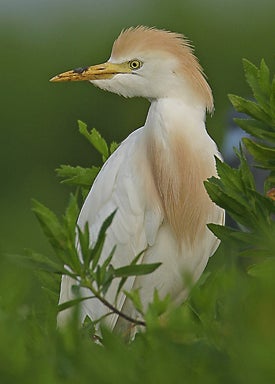SCIENTIFIC NAME:
Bulbulcus ibis
OTHER NAMES:
Cow Bird
STATUS:
Breeder. Common in spring, summer, and early fall in Inland Coastal Plain and Gulf Coast regions, and rare in winter. Uncommon in Mountain region in summer, but uncommon to rare during spring and fall. Fairly common in summer and early fall in Tennessee Valley region, but rare to uncommon in spring and late fall. Lowest Conservation Concern.
DESCRIPTION:
The cattle egret (Bulbulcus ibis) belongs to the large Ciconiiformes order of colonial wading birds, which includes various species of herons, ibises, egrets, and bitterns. Other water birds found in association with the cattle egret include cormorants and anhingas. The adult cattle egret is typically 20 inches in height, white with buff patches on the head, breast and back, and has a reddish bill and legs. Immature cattle egrets are all-white with a yellowish bill and dark-colored legs. A characteristic red eye distinguishes cattle egrets from other species of herons.
DISTRIBUTION:
In Alabama, the birds are only visitors; they begin arriving from Central America, Mexico and south Texas around March in the southern-most counties and as late as May in the northern-most counties. Cattle egrets breed from New England to the southeastern U.S. and west to the Great Lakes. Wintering birds may be found from Virginia south and west as far as Arkansas
FEEDING HABITS:
As their name implies, the birds frequently associate with cattle and have a mutually beneficial relationship. They can often be found on the backs of grazing cows feeding on many forms of insect life that often parasitize cattle. The cattle reap the benefits of reduced insect problems and the birds feed easily and undisturbed. Additionally, the abundant insect life found in growing cattle pastures affords a rich supply of food. Cattle egrets commonly forage in wet fields, marsh edges, and even recently cultivated agricultural fields.
LIFE HISTORY AND ECOLOGY:
The cattle egret roosts in heron colonies often composed of thousands of birds of several species. The colony sites are typically situated in two major habitat types: swamps and upland trees. Swamp habitat sites are generally composed of cypress, water tupelo, black willow and button bush. The upland colony sites are generally found in pine, sweet gum, and oak. Cattle egrets construct a crude nest of sticks beginning in May. Clutch size is usually four to five bluish-white eggs. Nesting activity may continue into August. Adults and young will continue to use the colony site as a roost until their departure in September through October.
Colony sites may often be used for years, with the birds returning, roosting, and nesting in the exact location annually. Satellite colonies adjacent to established colonies will frequently spring up. Colony life is usually longer in swamp habitat than in upland habitat types. This is because of the tremendous amount of droppings produced at colony sites. High concentrations of droppings will kill much of the vegetation in upland sites and often prompts the birds to move the colony. Swamp colony sites are not so adversely affected by large amounts of fecal matter, and therefore are generally more stable and longer lived.
In Alabama, cattle egrets have been found throughout the entire state but are rarely found in the Piedmont regions and other areas of heavy forestation. Currently, significant colonies can be found around Montgomery, Mobile, Tuskegee, Eufaula, Pansey, Gordon, Opp-Florala, and Faunsdale-Uniontown.
REFERENCES:
Harper and Row’s Complete Guide to North American Wildlife – Eastern Edition. 1981. Harper and Row Publishers, Inc, New York, NY. 714pp
Author:
Bill Gray, Wildlife Biologist, Division of Wildlife and Freshwater Fisheries







